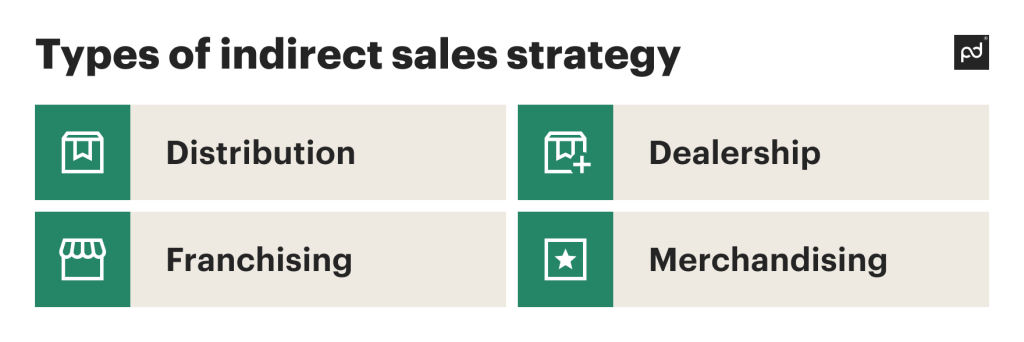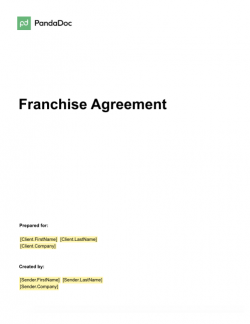In this article, we’ll cover how you can measure indirect sales success and discuss the four main types of indirect sales strategies: distribution, dealership, franchising, and merchandising.
We’ll also highlight the main advantages of indirect sales, such as expanding the sales network, increasing distribution efficiency, and minimizing costs.
In addition, we’ll give some examples of companies using this sales method and offer tips for successful indirect sales.
Key takeaways
- Indirect sales consists of selling products and services through intermediaries.
- Indirect sales can be measured through sales reports, market research, competitor analysis, and more.
- There are four main types of indirect sales strategies: distribution, dealership, franchising, and merchandising.
- Indirect sales channels offer advantages such as expanded sales networks, increased distribution efficiency, cost savings, scalability, and more.
What is indirect sales?
Indirect sales consist of selling products and services via partner companies, a type of sales collaboration.
This can include agencies and resellers. By using intermediaries, there’s no direct contact between the buyer and seller.
What is direct vs indirect sales?
In direct sales, you, the producer, sell your goods and services directly to the consumer.
There’s no intermediary. With indirect sales, your goods and services are sold to consumers by a third party.
On websites such as Etsy, for example, you’ll see sellers directly selling their own handmade products, and you’ll also see a lot of resellers.
Resellers will have bought products at wholesale prices and then sold them with a profit margin.
How do indirect sales work?
Indirect sales work by selling products and services through intermediaries.
These can be distributors, wholesalers, retailers, or sales reps. You, the supplier, produce the product, focusing on things such as manufacturing and quality control.
The intermediaries are essentially middlemen who distribute your product to the consumer.
Distributors will buy in bulk and resell to retailers.
They handle things like transport and warehouses.
Wholesalers buy products from the manufacturer or distributor and sell them to retailers.
Finally, retailers sell directly to consumers, managing physical and online stores.
As well as sales and marketing, their forte is customer service.
How to measure indirect sales
You can measure indirect sales using sales reports containing information on profits, sales trends, and how much of a product was sold.
You can also conduct market research to get data on consumer behavior and competitor analysis to get an idea of market demand.
Customer surveys are another option for measuring indirect sales as they can give you information about the retailer’s customer service, as well as the product itself.
Finally, you can use data analytics to look at website traffic and online sales, as well as social media performance.
Types of indirect sales strategy
There are four main types of indirect sales strategies:

Distribution
With distribution, the producer gives permission to retailers and wholesalers to sell their goods and services.
Their brand can be one of many represented by the retailers.

Distributor Agreement Template
Used 10473 times
4.4 rating (62 reviews)
This distributor agreement template lays out the terms for paying commission on the reselling or distribution on a service or product.
Use this templateDealership
When it comes to dealerships, the intermediaries consist of dealers.
They buy products at wholesale prices and resell them at a profit to other companies or individuals.
The difference is in the volume of products being resold.
Dealerships deal with larger numbers of products than distribution.
Franchising
Anyone can buy a franchise and effectively rent the trademark.
They make a profit while also paying interest to the brand owner.
The nice thing about this system is that you can use a tried and true method for your business.
You can use the logo, decor, color schemes, and everything else that is signature to that particular brand.
Pret à Manger, for example, has a distinctive image and a set menu.

Franchise Agreement Template
Used 6720 times
3.9 rating (17 reviews)
Use this free franchise agreement template to create binding contracts with your franchisees. The template contains extensive and customizable pre-written sections about involved parties, agreement terms, advertising, rights, franchise sale conditions, confidentiality, and franchise renewal.
Use this templateMerchandising
Merchandising can be part of an overall sales strategy that businesses use to promote and sell their goods and services.
It includes strategic pricing, how products are displayed, ads, and promotions.
The idea behind merchandising is to create a positive narrative and engage consumers while making the business as profitable as possible.
Advantages of indirect sales
The benefits of indirect sales are many.
Expansion of the sales network
With indirect sales, you can use intermediaries around the world to take your products from a local stage to a global one, reaching a lot more potential customers.
Increased distribution efficiency
Indirect sales allow you to distribute your products to people who know their customer base well, which reduces the chances of products going unsold.
Work efficiency
Indirect sales takes the pressure for things like advertising and pricing off the producer.
Expert merchandisers can take on this work instead, leaving you to focus on what you’re best at – creating goods and services.
Expert knowledge of different markets
As a producer, you may know your product inside out, but you don’t necessarily know where your product will be most popular.
By using indirect selling, you can channel your products toward experts who will understand the market better than you.
Larger target audience
Companies can funnel your products to their existing customer base, expanding your target audience and getting your brand known.
Cost saving
You can minimize in-house costs for things like distribution, marketing, and more by essentially allowing someone else to do those things.
You can instead just focus on making great products.
Scalable
Since the indirect sales process is easy to customize, you can scale production up and down depending on the state of the market.
Networking and trust-building
Since you’re entering into a business relationship with another company, you’re creating trust on the business platform and making a name for yourself.
You can also learn from other businesses and vice versa, as well as make new business contacts.
Lowers risk
Indirect sales allows you to test a new product via an established business without putting in a ton of work to get it to the consumer.
This means you can start with a small batch to see how it goes before deciding whether to invest more resources into the product.
4 indirect sales examples
Patagonia
Patagonia, the outdoor clothing and gear company, sells its products through authorized retailers and online shops, as well as its own stores.
Microsoft
Microsoft uses both direct sales and indirect sales techniques. It has its own online store, as well as physical stores.
It also partners with resellers, however, who sell its software and services to both businesses and individual consumers.
Lush
Lush, a sustainable cosmetics company, has a strong global presence.
Lush has its own stores but also uses a merchandising strategy by partnering with other retailers to sell its products to reach more customers.
Subway
Subway has a franchising model that allows individuals to open their own Subway restaurants.
Tips for indirect sales
Keep an eye on market trends
By keeping an eye on what people are buying and what competitors are doing, you can focus on staying relevant and competitive in the market.
Build solid relationships with intermediaries
Since you’ll be working closely with third parties, it’s vital that you form strong and cooperative relationships with clear communication.
Offer clear product information
You’ll want to make sure that your intermediaries know exactly what your product entails to be able to sell it effectively and answer customer queries.
It’s important to include details about specs, features, and pricing.
Give support and enticing offers
You can offer your intermediaries volume discounts, commissions on sales, and different types of support to help them with their work of selling your product.
Some manufacturers might send over product samples or provide marketing support and training.
Offer training
Conducting training sessions and offering materials can help intermediaries when it comes to understanding your services well.
They’ll then be able to sell with confidence and insight to the customer.
Keep an eye on feedback
Keep on top of any feedback you receive to improve your product and how you handle your business. You can also offer feedback to help intermediaries improve their sales rates.
PandaDoc’s sales software helps you automate proposals and speed up your deals
Indirect sales requires good cooperation, clear communication, and thorough market knowledge.
PandaDoc’s sales software can help you automate business proposals for quick deals and get you on your way toward a solid indirect sales solution.
Sign up for a 14-day trial and see what we can do for you.
Frequently asked questions
-
Another name for indirect sales is channel sales.
-
- Identify your target market
- Hone your product or service
- Research and reach out to potential intermediaries
- Establish relationships with intermediaries
- Offer training and support
- Monitor performance
-
- Identify your customers
- Decide on your product
- Find partners
- Connect with partners
- Train and support partners
- Check feedback
-
Indirect sales helps you use the expertise and networks of intermediaries and increase efficiency. You can focus on product creation while reaching a broader market and minimizing costs.
Disclaimer
PandaDoc is not a law firm, or a substitute for an attorney or law firm. This page is not intended to and does not provide legal advice. Should you have legal questions on the validity of e-signatures or digital signatures and the enforceability thereof, please consult with an attorney or law firm. Use of PandaDoc services are governed by our Terms of Use and Privacy Policy.


